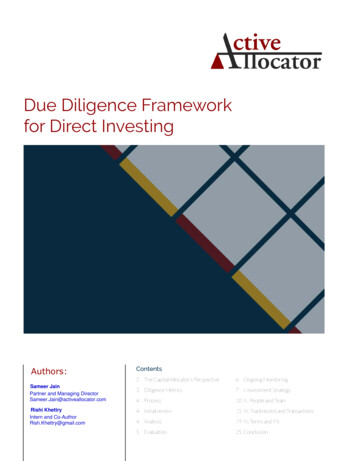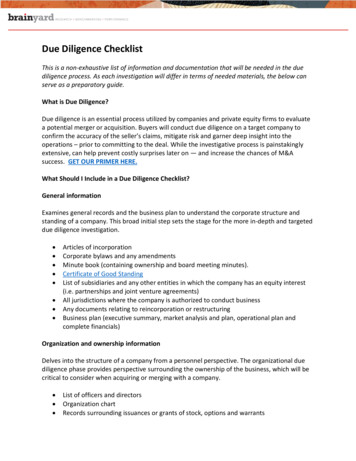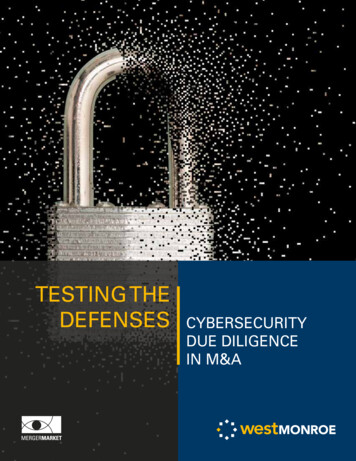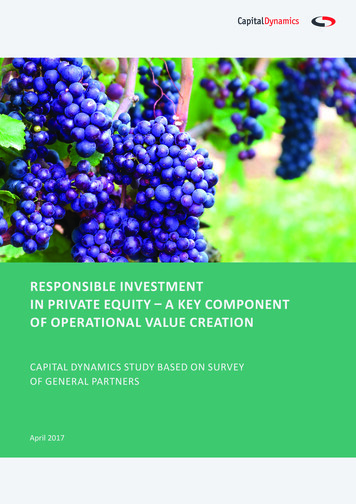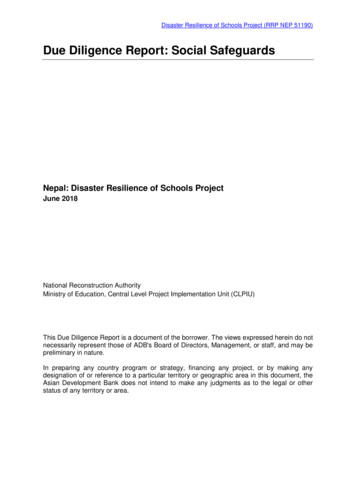
Transcription
BACKNEXTPrivate equitydue diligenceMitigate uncertainties and investwith greater confidenceplantemoran.comHOME
BACKNEXTContentsFinancial & tax due diligence3Mitigate transaction risk and discover potential“skeletons in the closet”Commercial & supply chain due diligence9Evaluate risk and determine future growth potentialIT due diligence15Uncover issues and prepare for actionCritical acquisition risks21Three additional areas to consider:Real estate22Employee benefits24Internal controls25HOME
BACKNEXTDue diligenceMitigate uncertainties and invest withgreater confidenceIn a time of historically heightened competitiveness in the private equityindustry, and with an increasingly constricting credit market, generatingstrong returns on your investment is more challenging than ever. Increasingseller expectations, shorter timelines to close, and the return pressure createdby high multiples mean that a robust diligence and post-close planning processare essential to high returns.Appropriate and tailored due diligence will provide you with an exhaustiveunderstanding of the target company — its market strength, customerrelationships, and financial performance — and close a deal at the mostfavorable transaction price. While we cannot eliminate risk, we can helpmaximize opportunities for success in an effort to generate the highest ROI.You already know how to make deals work. Our team will help you find thecompetitive edge to make deals work better.Michele E. McHalePartner, National Private Equity Group 1Plante MoranHOME
BACKNEXTFinancial &tax due diligenceMitigate transaction risk and discoverpotential “skeletons in the closet”The main goal of financial and tax due diligence is to mitigate the risksassociated with a transaction. It provides the buyer an opportunity to discoverpotential “skeletons in the closet” prior to an acquisition.As a starting point for any investment analysis, you must assess and verify theseller’s financial performance and tax compliance history. While the conceptis basic, the processes involved are anything but straightforward and requirecareful analysis.Financial due diligenceFinancial due diligence is typically the most thoroughly examined aspect ofthe due diligence process, but don’t let familiarity obscure the task at hand.A thoughtful and holistic approach is required to truly understand thepotential risk areas and their corresponding implications on the transaction.2Plante MoranHOME
BACKNEXTAssess capabilitiesAs a starting point, your target must be able to produce timelyand consistent financial statements.1It’s vitally important to analyze the numbers with an eye toward inconsistencies anddeviations from generally accepted accounting principles. Compare expenses against thoseof known competitors: Do they fall outside acceptable averages? If so, determine the reasonsfor the performance swings.Examine positionExamine the target company’s position in the marketplace,noting trends that could impact recent performance.2For instance, take a transaction involving a petroleum retailer. Financial performance couldappear exceptional, though a closer inspection could reveal inflated industrywide marginsdue to uncharacteristic oil pricing activity. A return to average pricing could significantlydeflate performance metrics, and thus valuation, commensurately.Determine future impactorsFinally, look carefully for any obscured events or decisions thatcan influence future post-integration earnings: An owner that hasn’t taken a salary3 Compensation levels for staff and management Healthcare and other benefit costs Legal issues, including settlements, that directly impact expenses Unpaid tax liabilities, including IRS liens and other issues caused by poor cashmanagement controls Dated ERP applications that don’t provide sufficient or even accurate financial metrics,such as inventory and WIPFour additional considerationsWhile each company and transaction is different, some consistent traps to avoid include:1234 INVENTORYCOSTING ANDVALUATIONPOOR CASHMANAGEMENTCONTROLSCOLLECTABILITYOF ACCOUNTSRECEIVABLE INEFFECTIVESYSTEMS ANDPROCESSESPrivate equity due diligence3HOME
BACKNEXTTax structuring, due diligence,and planningYou should view the tax implications of a proposed transaction holistically. Taxstructuring and tax due diligence are necessary to ensure your long-term taxobjectives are achieved.TAX STRUCTURINGTax structuring seeks to identify the optimal tax structure for a transaction,preferably one that achieves a step-up in the tax basis of assets.Possible ways to achieve a step-up may include: Direct asset purchase Deemed asset purchase (e.g., Section 338(h)(10) or Section 336(e) elections,purchase of a disregarded entity) Purchase of an ownership interest in a partnership or limited liabilitycompany that’s classified as a partnership for tax purposes Unilateral Section 338(g) election to treat a stock purchase as an assetpurchaseTAX DUE DILIGENCETax due diligence should be tailored to your target entity’s tax classification(C corporation, S corporation, limited liability company, or partnership) aswell as the structure of the transaction from a tax perspective. To the extentthat you’ll assume historical tax exposures given the legal form of thetransaction, potential tax exposures should be addressed in the transactiondocuments as well as post-close.In certain instances, tax exposures may be so significant that they cause thetax structure of the proposed acquisition to be altered. You may be subject tostate and local successor liabilities laws even in transactions structured asdirect asset purchases.Common areas of focus during due diligence may include: Failure to file required tax returns Missing elections or forms (e.g., reporting of a transaction, accountingmethod changes, safe-harbor elections, transactions between related parties) The validity of the S corporation status of the target company Related-party transactions (arm’s length)4Plante MoranHOME
BACK Previous acquisitions, dispositions, or legal reorganizations Timing of deductions and revenue recognition policies Payroll withholding taxes and the misclassification of employees ascontractors Executive compensation, golden parachutes, and bonus structure/incentive plan. State sales and use tax issuesTAX PLANNINGYour deal team should recognize the interplay between tax structuring and taxdue diligence when planning a transaction. In doing so, historical tax exposuresmay be mitigated, and costly future tax compliance mistakes will be avoided.Additionally, the potential impact upon ROI may be minimized, and dealproceeds will be maximized upon future exit.Private equity due diligence5NEXTHOME
BACKNEXTCommercial & supplychain due diligenceEvaluate risk and determine futuregrowth potentialCommercial due diligence, especially involving your target’s customer baseand supply, is critical for obtaining an accurate view of their operations andposition in the marketplace. The underlying goal must be one that presents arealistic view of the acquisition’s future growth potential, an assessment thatrelies on three distinct analyses: operational stability, market strength, andforecast validation.Without a thorough review of each, you risk assuming vulnerabilities that canfrustrate the most well-intentioned projections, dragging down earnings, andultimately ROI.Commercial due diligenceWhile financial due diligence delivers critical details about historical trends,it’s important not to overlook an examination of recent business performance,which can yield important insights into projected future earnings. To that end,6Plante MoranHOME
BACKNEXTthe due diligence process should include a strategic, commercial analysis tounderstand the qualitative aspects that drive corporate performance.Consider these five areas:Customer counts1The true value of a company’s future earnings is directly tied to itscustomer base.To assess the strength of the seller’s customer list, analyze the customer base. Disproportionaterevenues coming from a select few clients indicates the customer list may be less stable than if saleswere spread evenly over a number of clients.The durability of customer relationships is critical for meeting future expectations. As such, it’simportant to understand the level of intimacy with the top purchasers, as well as the employeesresponsible for maintaining those touchpoints.Product line strength2No matter the strength of your customer base, you risk compromisingtheir loyalties without a quality product line.Examine the seller’s portfolio carefully to gauge product stability, paying close attention to newofferings, and weighing those against the seller’s skill set and alignment with future customerdemands.As to the seller’s skill set, verify whether those self-professed attributes are capable of delivering theresults that they promise. If not, you’ll need to determine whether those skills are easily obtainedelsewhere — and at what cost.Sales projectionsIf sales are spiking higher, look to see whether the increase is organicor attributable to risk-related events.3If the latter, distinguish risks that are fleeting or long-term risks in order to gain an appreciation oflikely disruptors.Assess whether forecast projections are logical in the context of your target’s customer relationships.For instance, if sales with a tech startup are projected to triple, due diligence will flag that projectionand perform a more realistic assessment.Perform a comprehensive industry analysis to understand short- and long-term trends, notingany uncertainties. Some industries in particular bear close scrutiny, including healthcare, energy,telecommunications, and manufacturing. You need to look no further than the case of Blackberryto understand how quickly technology evolves and the importance of reviewing current consumertrends and performance data to predict future performance.Private equity due diligence7HOME
BACKNEXTSizing up the competition4Assess the seller’s marketplace position and value propositions againstthose of its competitors.Like the Blackberry, look for factors (technology, consumer preferences) that could threaten longterm financial health while charting the growth (or decline) of their market share. If there’s beenrecent M&A activity among competitors, that could also impact future earnings.Salesforce dynamics5Explore the fundamentals of the seller’s sales organization tounderstand how business is secured and retained.This can reveal hidden, though important, business relationships. For instance, certain industriesoffer ongoing price reductions. If so, make sure the seller has been accommodating these uniqueexpectations, to ensure your post-integration projections are accurate.Supply chain due diligenceAt a time when supply chains have evolved to become truly global andborderless, the risks for disruption have never been greater.Market fluctuations, volatile foreign exchange rates, political turmoil, laborunrest, and natural disasters all present risks that can interrupt the supplychain, causing part shortages and production slowdowns (or even shutdowns).In some instances, they can impact cash flow and trigger financial instability.Recognizing the sizable risks the supply chain can pose, a critical elementof your commercial due diligence should include a thorough review of theacquisition’s supply chain. As such, performing a comprehensive review of thesupply chain is critical for properly measuring your target’s risk, stability, andeven potential for future growth.8Plante MoranHOME
BACKNEXTRISK MITIGATION CONSIDERATIONSConsider spend concentrationLook carefully at the spend concentration among suppliers, particularly for highly strategic/critical commodities and categories. If there doesn’t appear to be a balance of qualifiedsuppliers in critical categories, this could be pointing to potential risk with supply chaindisruptions.Note any products that are procured from a single source. Such an arrangement may presentprofound risks, depending on the supplier’s stability, whether it offers backup facilities, andits sphere of operations.Determine the supplier’s footprintAssess the footprint to understand any known or probable risks, such as those related togeopolitical, disaster, political, economic, or environmental factors. And especially when thetarget has relied on a single supplier, understand the availability of other qualified suppliers,should an event compromise supplies from the primary source.Review contractsFor suppliers that provide exclusive products or materials, the weight of the targetcompany’s contract can impact fulfillment. That is, if the company presents a very smallpercentage of the supplier’s business, delivery during a supply chain event may face a greaterchance of disruption than if they represented a larger percent of the supplier’s business.Examine supplier performanceNext, review all supplier relationships, assessing their performance and strength. Theformer is tied to specific metrics — cost, quality, and delivery — while the latter addressesmore subjective dynamics based on trust, collaboration, and efficiency. Understand whichsuppliers are thriving and where there are opportunities for improvement.Assess management processesFinally, while the target may (and should) maintain robust supply chain monitoring, does thesupplier offer the same? Assess, if possible, the supplier’s qualifications and managementprocesses of their supply chain. Such an analysis will provide a truer picture of the totalsupply chain risk.Private equity due diligence9HOME
BACKNEXTIT due diligenceUncover issues and prepare for actionThere’s perhaps no segment of business operations that’s evolving andchanging as rapidly as information technology (IT). As IT impacts nearlyevery business function, it’s imperative to conduct a thorough due diligenceof the target company’s information technology systems and operations tounderstand what you stand to inherit with your acquisition as well as whatyou may need to do to address significant gaps and issues that may inhibitfuture growth.Additionally, since effective operational data is needed to begin any operationsimprovement, it’s vital to engage in IT due diligence quickly to ensure aneffective and efficient transition.10Plante MoranHOME
BACKNEXTNOT FOR EVERYONEMany companies overlook IT due diligence, either because they fail to recognize its value,or because the target is relatively small. However, size alone should not determine whetheryou conduct IT due diligence. We recommend performing IT due diligence if the targetmeets any of the following criteria: 30M thresholdTech-relatedIf the target is a manufacturer, distributor, orservice organization with revenues of at least 30 million and for whom technology plays animportant aspect of the business (inventorycontrol, traceability, etc.), it merits IT duediligence. At such a size, scalability and technologymanagement create an increased risk and cost forthe acquiring firm.If the target’s core assets or service offeringsare technology-based, conduct IT due diligence,irrespective of revenues. Custom developedapplications for the marketplace can introduceunique risks to an acquiring firm. EnsuringSoftware Development Lifecycle (SDLC)standards are in place and followed enhances thelikelihood of quality solutions.Consumer facingRegulatory complianceIf the target organization facilitates businessto consumer transactions, then performIT due diligence. A company that conducts onlinesales transactions and handles credit card data,for instance, faces significant compliance riskas well as future scalability concerns as theorganization grows.If the target company operates in an industrythat is subject to regulatory compliance(FDA, ITAR, DOT), there are elevated risks iftechnology solutions are not appropriatelydeployed. Evaluating current processes andtools will identify potential gaps in the existingtransactions and outline potential costs toresolve existing gaps.Three principal considerationsThere are three principal considerations associated with your target’sinformation technology: gaps, risks, and costs. The goal of any comprehensiveIT due diligence process should be to identify and assess their impact.1GAPSAssess the target for any technology, staffing, or licensing gaps that you mayneed to address over the next three to five years, with a firm understanding oftheir underlying costs and potential impact on the business.Private equity due diligence11HOME
BACK2NEXTRISKSUnderstand the risks related to the IT environment. Are adequatesafeguards in place related to employee training and access? Doprocesses align with best practices, or at a minimum, do theycomply with industry standards? Is there existence of customdeveloped business applications or business solutions that are nolonger supported by the vendor? Elevated risks could impact yourpurchasing decision.3COSTSDetermine the IT costs, both recurring and nonrecurring, over thenext five years of a potential hold period. For instance, if the targetemploys 100 people who each work at an old computer runningoutdated software, replacing the hardware and software will bear asubstantial cost.Three assessment areasWe recommend reviewing three core elements during the IT due diligenceprocess: business applications, traditional IT components, and IT governanceprocesses.1BUSINESS APPLICATIONSBusiness applications help “run” the business and include ERP solutionsand business intelligence.Both must be current and fully supported by their software vendor.Beware of companies whose business applications are common(i.e. Excel); despite their ubiquity, they may not provide sufficientvisibility into the company’s performance.Determine whether the applications include the requisite licensesand contracts. Pirated software (copied applications that are inviolation of copyright laws) is illegal and noncompliant with licensingrequirements. As such, it presents a significant legal risk to you aswell as a steep replacement cost.12Plante MoranHOME
BACKAdditionally, if there is a goal to assimilate the new target company toan existing portfolio, then special consideration will need to be placed inevaluating how redundant applications will be handled. Maintenance ofmultiple ERP solutions typically increases cost of support staff while reducingefficient reporting capabilities.2TRADITIONAL IT COMPONENTSTraditional IT applies to a company’s IT infrastructure and includesnetworks, servers, security, communication software, and staffing.Assess these components to determine if the performance, size, andcapabilities are appropriate for the target’s business and its requirements.Note whether there are elements that need a refresh or capital investment. Forthose items that require software maintenance patches, analyze their refreshschedule to make sure it’s dependable and that all updates are current.Review documentation and logging of all hardware, too, including servers,switches/routers, and security devices. Finally, examine the basic IT hardware,especially computers; while a laptop may function for a decade or more, werecommend a refresh cycle of three to five years. Anything older and youshould consider its replacement cost in your final valuation.3IT GOVERNANCE PROCESSESIT governance concerns how the target makes and administersIT decisions.For some, this may include a forward-looking strategy for IT, with a projectoversight office that’s in close contact with IT to approve IT funding.Additionally, IT governance controls how the target supports its end users.Some organizations maintain a help desk that manages hardware andsoftware issues of the company’s employees. Review what, if anything, thetarget has in place, and consider what you may need to contribute to thepost-integration entity.Private equity due diligence13NEXTHOME
BACKNEXTCritical acquisition risksThree additional areas to considerThe due diligence process for target acquisitions should extend beyond what’sevident — financial performance, tax liabilities — and cover those elementsof business operations and holdings that present tangible implications for thepost-integration entity.This section considers three critical, though often overlooked, areas fraughtwith risk:REAL ESTATEEMPLOYEE BENEFITS14INTERNAL CONTROLSPlante MoranHOME
BACKReal estateWith so much attention directed to your target’s finances and performancetrends, you must not overlook the land and buildings involved in anyprospective deal, as property can have a substantial impact on the performanceof the post-integration entity.As part of the initial due diligence stage, assess the target company’s real estateportfolio. Will you be inheriting a lease agreement or purchasing real estate aspart of the transaction?If you stand to inherit the lease, there are a number items to factor into yourvaluation. Determine your rights and duties versus the landlord’s rights andduties, including any obligations regarding maintaining mechanical systems,parking lots, or restoring the facility back to its “original” state. Includescheduled rent escalations into your ROI projections, and don’t forget detailsregarding termination provisions or renewal options, including the timing ofnotice provisions. The type of lease (triple net, absolute net, modified gross,gross, etc.) may also carry unique financial considerations. Finally, performa mark-to-market assessment of the real estate, categorizing them as above,below, or at market.If you’re inheriting the real estate portfolio as part of the acquisition,consider a facility condition assessment to uncover deferred maintenance ordeficiencies of the facility. Additionally, as you consider the growth potentialof the post-integration company, consider a sale-leaseback arrangement ofreal estate. Such a vehicle can generate immediate funds to pay down debt orexpand operations, while affording you the opportunity to reposition the asset.Whether you inherit a lease or the actual facility, investigate existingincentive agreements on a state and local level. These agreements can exert atremendous liability on the post-integration entity, necessitating an exhaustivedue diligence review. If they exist, review any clawback provisions of theagreement. Does the incentive agreement coincide with your long-term vision?Will the facility location need to be consolidated or relocated? If so, determinewhether you can rework the incentive agreement prior to closing as you maylose leverage to modify it afterward.Private equity due diligence15NEXTHOME
BACKNEXTTHE PATH TO SUCCESSInheritinga leaseagreement?Inheriting areal estateportfolio?DetermineUncoveryour rights and duties versus thelandlord’s rights and dutiesdeferred maintenanceor deficienciesIncludePerformscheduled rent escalations intoyour ROI projectionsa mark-to-market assessmentConsiderPerforma sale-leaseback arrangementa mark-to-market assessment16Plante MoranHOME
BACKEmployee benefitsAccording to the U.S. Bureau of Labor Statistics, employee benefits averagein excess of 30 percent of the total costs for employee compensation for theprivate sector, with costs in some industries averaging much higher. Therefore,it’s easy to see the importance of conducting a thorough review of employeebenefits costs for your target company.The impact of employee benefits on future earnings can be considerable,especially for major legacy expense items such as pension obligations and OPEB(other [than pension] post-employment benefits) liabilities such as healthcarebenefits, life insurance, and disability. These liabilities can extend beyond thetarget company following a deal. In fact, a recent court ruling found multipleprivate equity funds managed by a major private equity firm to be jointly andseverally liable for unfunded pension liabilities owed by a bankrupt portfoliocompany. When looking at a financial statement, review its long-term liabilitiescarefully, as the actuarial assumptions and methods prescribed to establishOPEB financial statement liabilities do not provide an accurate reflection of theactual long-term impact on cash flow.WHEN LOOKING AT A FINANCIAL STATEMENT, REVIEW ITSLONG-TERM LIABILITIES CAREFULLY,as the actuarial assumptions and methods prescribed to establish OPEBfinancial statement liabilities do not provide an accurate reflection ofthe actual long-term impact on cash flow.Finally, evaluate other employee benefits-related items, including thosetied to IRS and/or DOL compliance, employee reactions to anticipatedbenefits changes, potential need for preemptive negotiations with unionrepresentatives, and potential union pension withdrawal liability. All of thesecan impact the performance of the post-integration company, which must beaddressed prior to finalizing the purchase.Private equity due diligence17NEXTHOME
BACKNEXTInternal controlsWith significant focus on quality of earnings, the due diligence processfor target acquisitions often fails to identify deficiencies within the targetcompany’s internal controls environment — key factors that pose postintegration risks.Family-owned target companies are especially prone to these internalcontrols shortcomings, with a lack of resources to deliver accurate financialinformation.In order for you to address this risk, in addition to performing the necessarydue diligence on the target’s financial records — its quality of earnings andbalance sheet health in an effort to assess EBITDA and calculate a valuation —special attention must be directed at your target’s internal controls. It’s one ofthe most effective ways to ensure that the financial information is reliable.For instance, if your target lacks controls to correctly determine whethera recorded sale is a valid sale (or worse, inflates the transaction to boostearnings), the earnings assessment will produce inaccuracies. Additionally, alack of proper controls can also result in complacency at the expense of salesefficiency (timeliness) and accuracy (proper recording). Both of these scenariospose significant risks to achieving your post-integration performance goals.CONSIDERATION OF THE TARGET’S REPORTING SYSTEMS,METHODOLOGY, AND EFFICIENCY WILL BE A KEYDETERMINATE IN A SUCCESSFUL ACQUISITION.As you evaluate your target’s internal controls, we encourage assessing thecapabilities of your target’s existing finance team. As you consider the properforward-looking strategy for your target, having a solid financial reportingfunction is key to maintaining and supporting organizational growth andchange. Is the current finance team qualified and capable of handling yourreporting demands and requirements? Assessment of the finance teammay also include revamping your target’s financial reporting framework.Consideration of the target’s reporting systems, methodology, and efficiencywill be a key determinate in a successful acquisition.18Plante MoranHOME
For more information, please contact:Michele E McHalePartner, National Private EquityGroup Stay in the know: subscribe.plantemoran.comMatthew PetrucciPartner, Transaction AdvisoryServices plantemoran.com
Due diligence Mitigate uncertainties and invest with greater confidence Michele E. McHale Partner, National Private Equity Group Leader 248-223-3579 michele.e.mchale@plantemoran.com In a time of historically heightened competitiveness in the private equity industry, and wi
